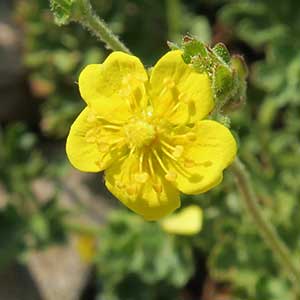|
short-leaf cinquefoil, sparse-leaf cinquefoil
|
crested cinquefoil, crested potentilla
|
|
Plants tufted to densely matted; caudex branches usually short, stout, sometimes embedded in old leaf bases. |
|
ascending to erect, 0.3–2 dm, lengths 2–3 times basal leaves. |
petiole 1–4 cm, eglandular hairs absent or sparse, spreading, less than 1 mm, weak, glands abundant. |
not in ranks, ternate, 1–5(–9) cm; stipules: apex acute to obtuse; petiole 1–4 cm, long hairs absent or sparse to common, spreading to ascending, 0.5–2 mm, ± weak, glands sparse to abundant; leaflets 3, central flabellate, 0.4–2 × 0.5–1.5 cm, petiolule 1–3 mm, margins flat, distal 3/4+ deeply 3–5-lobed (sinuses extending 1/2 to nearly to midvein), lobes unevenly incised 1/4–1/2 to midvein, teeth 2–5 per lobe, surfaces similar, dark green, hairs ± sparse, 0.5–1.5 mm, glands sparse to abundant. |
|
1–7-flowered. |
|
straight, 0.2–1.2(–2) cm, not much longer in fruit than in flower. |
epicalyx bractlets lanceolate-elliptic to ovate, 2–4 × 0.8–2 mm; sepals 3–5(–7) mm, apex broadly acute to obtuse; petals 3.5–6.5 × 3–5 mm; filaments 1–2.5 mm, anthers 0.5–0.6 mm; carpels 10–15. |
epicalyx bractlets broadly ovate, 2–4 × 2 mm, margins flat; hypanthium 3.5–6 mm diam.; sepals 3–5 mm, apex broadly acute to obtuse; petals yellow, 3–5.5 × 4–5 mm; filaments 0.7–1.7 mm, anthers 0.5–0.6 mm; carpels 25–40, styles tapered-filiform, ± papillate-swollen in proximal 1/5–/1/3, 1.3–2 mm. |
1–1.5 mm. |
1–1.5 mm, dorsally crested. |
|
= 42. |
|
|
|
|
| Flowering summer. |
Flowering summer. |
| Moist rocky slopes and talus, alpine grassy areas, subalpine conifer woodlands |
Rocky, open, serpentine slopes, in conifer woodlands |
| 2500–3600 m (8200–11800 ft) |
1800–2800 m (5900–9200 ft) |
|
ID; MT; NV; OR; WY
|
CA |
Potentilla brevifolia is found mainly in alpine situations in the Pioneer, Sawtooth, Smoky, and White Cloud mountains of central Idaho; the Madison Range of western Montana; the Jarbidge Range of northeastern Nevada; the Blue, Steens, and Wallowa mountains of eastern Oregon; and the Teton Range of northwestern Wyoming. The elongate caudices are easily covered by moving soil and talus. (Discussion copyrighted by Flora of North America; reprinted with permission.) |
Of conservation concern. Potentilla cristae is known only from Cory Peak, Mount Eddy, and the Marble Mountains in northwestern California. In addition to the characteristics in the key, the species is distinctive in having a low dorsal crest on the achenes, hence the specific epithet. (Discussion copyrighted by Flora of North America; reprinted with permission.) |
| FNA vol. 9, p. 188. |
FNA vol. 9, p. 191. |
| Rosaceae > subfam. Rosoideae > tribe Potentilleae > Potentilla > sect. Brevifoliae |
Rosaceae > subfam. Rosoideae > tribe Potentilleae > Potentilla > sect. Aureae |
P. albiflora, P. ambigens, P. anachoretica, P. angelliae, P. anglica, P. anserina, P. arenosa, P. argentea, P. arizonica, P. basaltica, P. bicrenata, P. biennis, P. biflora, P. bimundorum, P. bipinnatifida, P. breweri, P. bruceae, P. brunnescens, P. canadensis, P. concinna, P. cottamii, P. crantzii, P. crebridens, P. crinita, P. cristae, P. demotica, P. drummondii, P. effusa, P. elegans, P. erecta, P. flabellifolia, P. fragiformis, P. furcata, P. glaucophylla, P. gracilis, P. grayi, P. hickmanii, P. hippiana, P. holmgrenii, P. hookeriana, P. hyparctica, P. inclinata, P. intermedia, P. jepsonii, P. johnstonii, P. lasiodonta, P. litoralis, P. macounii, P. millefolia, P. modesta, P. morefieldii, P. multijuga, P. multisecta, P. nana, P. newberryi, P. nivea, P. norvegica, P. ovina, P. paucijuga, P. pedersenii, P. pensylvanica, P. plattensis, P. pseudosericea, P. pulchella, P. pulcherrima, P. recta, P. reptans, P. rhyolitica, P. rimicola, P. rivalis, P. robbinsiana, P. rubella, P. rubricaulis, P. sanguinea, P. saximontana, P. sierrae-blancae, P. simplex, P. sterilis, P. stipularis, P. subgorodkovii, P. subjuga, P. subvahliana, P. subviscosa, P. supina, P. thurberi, P. thuringiaca, P. tikhomirovii, P. townsendii, P. uliginosa, P. uschakovii, P. vahliana, P. verna, P. versicolor, P. villosa, P. villosula, P. vulcanicola, P. wheeleri |
P. albiflora, P. ambigens, P. anachoretica, P. angelliae, P. anglica, P. anserina, P. arenosa, P. argentea, P. arizonica, P. basaltica, P. bicrenata, P. biennis, P. biflora, P. bimundorum, P. bipinnatifida, P. brevifolia, P. breweri, P. bruceae, P. brunnescens, P. canadensis, P. concinna, P. cottamii, P. crantzii, P. crebridens, P. crinita, P. demotica, P. drummondii, P. effusa, P. elegans, P. erecta, P. flabellifolia, P. fragiformis, P. furcata, P. glaucophylla, P. gracilis, P. grayi, P. hickmanii, P. hippiana, P. holmgrenii, P. hookeriana, P. hyparctica, P. inclinata, P. intermedia, P. jepsonii, P. johnstonii, P. lasiodonta, P. litoralis, P. macounii, P. millefolia, P. modesta, P. morefieldii, P. multijuga, P. multisecta, P. nana, P. newberryi, P. nivea, P. norvegica, P. ovina, P. paucijuga, P. pedersenii, P. pensylvanica, P. plattensis, P. pseudosericea, P. pulchella, P. pulcherrima, P. recta, P. reptans, P. rhyolitica, P. rimicola, P. rivalis, P. robbinsiana, P. rubella, P. rubricaulis, P. sanguinea, P. saximontana, P. sierrae-blancae, P. simplex, P. sterilis, P. stipularis, P. subgorodkovii, P. subjuga, P. subvahliana, P. subviscosa, P. supina, P. thurberi, P. thuringiaca, P. tikhomirovii, P. townsendii, P. uliginosa, P. uschakovii, P. vahliana, P. verna, P. versicolor, P. villosa, P. villosula, P. vulcanicola, P. wheeleri |
| Nuttall: in J. Torrey and A. Gray, Fl. N. Amer. 1: 442. (1840) |
Ferlatte & Strother: Madroño 37: 190, fig. 1. (1990) |
| |


